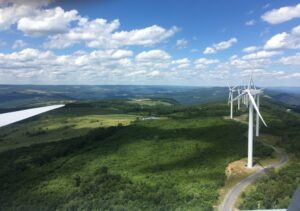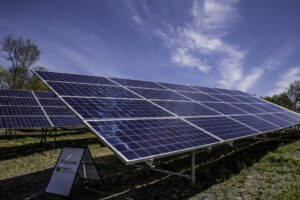Charting the Path to 100% Clean Energy

Generating 100% of our electricity from clean energy is an idea that has captured the imagination of lawmakers, voters, corporate leaders, and companies like Clearway alike. Over the last two years, ten states and more than one hundred cities have enacted policies to become 100% carbon-free by mid-century, and at least 100 million people live in a place committed to that goal.
In the flurry of headlines around new mandates for 100% clean energy by 2050, each time we noticed only brief mention of an important detail: nearly all legislation and executive orders also included more modest, but still significant, renewable energy requirements in the next decade. Maine’s recently-passed 100% by 2050 RPS bill, for example, includes a benchmark requirement of 80% renewables by 2030, while New York requires 70% by the same year. Every single state with a 100% law – from New Mexico to California to Minnesota – pencils in a near-term milestone.
We are thrilled to help deliver on ambitious clean energy goals. Now that the ink is dry, it’s time to buckle down on the incremental steps it will take to reach those goals. Addressing the immediate need to back-up intermittent wind and solar, developing robust transmission, enabling both large-scale and local energy, and transitioning the conventional energy workforce are all paramount to meeting everyone’s needs for a reliable, competitively-priced, and clean energy system.
As we applaud the goal of a complete transition by mid-century, we’ve set our sights on what it will take to reach the 10-yard line. We believe that these near-term milestones are equally – if not more – impactful in the immediate fight against climate change. We also recognize that reaching 80 or 90% quickly is better than achieving 100% never. Current technology, market, and cost constraints make it difficult to know exactly how that remaining portion will be met.
Getting from our goal line to the other side of the field: The role of natural gas
For all the economic, environmental, and climate benefits, two major challenges persist with solar and wind: when it’s generated, and where. In the long run, when paired with energy storage technologies and a robust transmission system, renewables can provide round-the-clock power for most of America, and increasingly do so at a lower cost than fossil fuel generation.
While our industry is pursuing that future, though, there is an essential and relatively beneficial solution for intermittency in the form of modern natural gas generation. While many in the renewable and environmental community consider any use of natural gas problematic, there is in fact a role for gas that increases the likelihood of long-run climate success. In a number of parts of the country, the use of modern, efficient, and existing natural gas peaker power plants – located in the right places in the electric grid – assure the reliable and rapid growth of renewables to reach the 10-yard line. For the next two decades, we believe that clean peaking natural gas generation must remain in our country’s playbook in order to meet our clean energy targets reliably and cost-effectively.
In this way, natural gas plays a role in enabling higher renewable penetration by firming renewable power – that is, filling in the gaps of its inherent intermittency – while also paving the way to much-needed energy storage and new transmission. So while we’re focused on addressing some of the biggest barriers to quickly deploying as much solar and wind as possible, we also recognize the practical role for gas technology in enabling rapid deployment of renewables while maintaining grid reliability.
The long pass: The criticality of robust transmission

Looking further down the field, let’s take a closer look at two major opportunities to expand renewable energy. When it comes to wind energy, one of the biggest barriers to deployment is distance. Much of the country’s best wind resources are in rural or remote regions far from dense population centers. Transmission lines are the only way to move large-scale wind power from where it’s generated to where it’s needed. Transmission lines are cost-effective, but they are also complex to develop and build – even when they offer the ability to save money for customers.
The primary challenge is jurisdictional: transmission infrastructure cuts across many different regional and state authorities, including both private and public land, making it one of the most controversial and difficult infrastructure investments we face. Compounding the problem is the lack of a single overarching authority to regulate and approve such transmission investments that cross multiple jurisdictions.
Clearway and the renewable industry support workable policies for how transmission is planned, permitted, and paid for. Multiple studies have shown that investments in transmission typically yield benefits 2.6 to 3.9 times their cost, because they are improvements to the grid that make it more flexible, resilient, and better able to resist cyberattacks.
The distributed generation ground game

In addition to delivering large-scale renewables from rural regions, a necessary part of getting to 100% is harnessing energy right where it’s used. That is where distributed generation comes in. And while rooftop solar offers one proven path, 75% of households and businesses in the U.S. face physical or financial barriers that prevent them from installing solar on their own property. Enter community solar. Community solar offers local clean energy choices to those families and businesses who can’t have or don’t want solar panels on their property while also reducing the need for cities and states to wait for sometimes complex, multi-jurisdictional transmission development. In fact, one study found that if all states allowed community solar, it could reach between 57 GW and 84 GW nationwide by 2030, serving as many as 8.8 million customers and solving a large part of the 100% puzzle.
What’s more is that this model offers an opportunity to not just make progress on the next decade’s clean energy requirements, but also generate enormous local benefits ranging from local jobs, economic development, and a more robust property tax base for under-resourced municipalities, to healthier communities, utility bill savings, and more resilient local electricity grids as community solar is increasingly paired with distributed storage.
Yet despite its transformative potential, only a handful of states have a meaningful community solar program at scale, with many existing programs that are undersized or designed as small “pilots” and not creating any real dent in the path to 100%. State lawmakers play an essential role in ensuring that everyone – regardless of where they live or what they earn – has the option to choose local, clean, affordable solar energy. Today, most states have yet to give residents and businesses that choice.
Crossing the goal line: Storage paired with renewables
Energy storage is key to reaching the endzone of 80-100% carbon-free electricity because it allows generators to store clean power for later use during periods of higher demand. When paired with solar, it can store energy generated when the sun is shining and be deployed in the evenings when consumer demand peaks. And while the cost of storage continues to decline, it is already proving competitive. In Hawaii, our 75 MW of solar development will be paired with 300 MWh of storage capacity, as will much of our solar development pipeline in California, Massachusetts, and elsewhere moving forward.
Recognizing that energy storage is a technology that continues to evolve, there are several policy efforts at both the federal and state levels to expand its deployment and to help drive costs down. If passed, the federal Energy Storage Tax Incentive and Deployment Act would make storage eligible for the existing investment tax credit, which currently only applies to storage when it’s integrated with ITC-eligible solar resources. On the regulatory front, FERC Order 841, which directs regional grid operators to remove barriers to the participation of storage in wholesale markets, is an important step toward the commercialization of storage.
Charting a just transition to 100% clean energy
As the undeniable cost of fossil fuel emissions on people’s health and the environment continues to grow, the cost of wind and solar power have declined dramatically, as have the costs of firming them with modern natural gas and, increasingly, energy storage. We are now at a moment where we can choose renewable generation that doesn’t impose costs on human health, our planet, or ratepayers. As a result, states and markets around the country have rapidly adopted renewable energy and natural gas, leading to the retirement of more costly and harmful coal plants. All the while, utilities and grid operators have successfully maintained and even improved grid reliability.
But the decline of coal has come with its own cost. Over the last several years, coal communities have seen jobs lost and property taxes decline. We believe that in order to achieve a just energy transition, the industries that thrive in that transition must plant roots and invest in the people and economies of the communities with the most to lose. And with a pipeline of solar, wind, and storage development across the country, we intend to be a part of the just transition. While many of our own workforce came from the conventional fuel industry, we hope that is just the beginning.
Getting to work
As we train our focus on the milestones along the way to 100%, we should consider our full suite of options that complement renewable and climate goals. Use of fast-ramping natural gas generation, transmission line development, distributed generation, battery storage, and other clean back-up technologies such as demand-side management and pumped-hydro power, can all support renewable generation while providing consumers with both cost-effective and reliable power. We must also ensure that no one is left behind in our clean energy economy.
The good news is that solving these problems is well within the realm of possibility. Commenting on New York’s recently-passed Climate Leadership and Community Protection Act, one of the world’s most ambitious climate plans, the editorial board at The Buffalo News wrote, “the story of American progress is the repeated rise of new and better solutions eclipsing the old.” We couldn’t agree more.